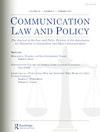Bollinger, L.C. Jr. Freedom of the Press and Public Access: Toward a Theory of Partial Regulation of the Mass Media, 75 Mich. L. Rev. 1 (1976)
IF 0.2
Q4 LAW
引用次数: 0
Abstract
In selecting my article, I pivoted at decision time from an article that was influential in my development as a scholar to one that has recently begun to strike me as particularly relevant to ongoing policy debates about social media platforms, despite falling a bit out of favor over the years. With that brief preface, I’ll begin my revisiting of Lee Bollinger’s 1976 article, and attempt to make the case that his defense of the regulatory distinctions that separate print and broadcast media in the United States may be useful in developing a regulatory framework for social media that is distinct from the rest of the Internet. Bollinger starts from the premise that there are both First Amendment benefits and costs associated with government intervention in the media sector. The benefits Bollinger focuses on are derived from the role that the government can play in ensuring “the widespread availability of opportunities for expression within the mass media.” Consequently, the partial regulatory system that emerged (with a regulated broadcast sector and unregulated print sector) is one that “captures the benefits of access regulation yet still minimizes its potential excesses.” Bollinger contends that, in upholding government intervention in the broadcast sector as constitutional, the Supreme Court of the United States “pursued the right path for the wrong reasons.” Specifically, the logic and rationality of this bifurcated regulatory framework did not have to be justified on the basis of any unique characteristics of broadcasting, such as spectrum scarcity (as it has been,《新闻自由和公众访问:走向大众媒体的部分管制理论》,《密歇根大学学报》第75卷第1期(1976年)
在选择我的文章时,在做决定的时候,我从一篇对我作为学者的发展有影响的文章转向了一篇最近开始让我觉得与正在进行的关于社交媒体平台的政策辩论特别相关的文章,尽管多年来有点失宠。在这篇简短的序言中,我将开始重新审视李·博林格(Lee Bollinger) 1976年的文章,并试图证明,他对美国印刷媒体和广播媒体监管区别的辩护,可能有助于为社交媒体制定一个与互联网其他部分截然不同的监管框架。Bollinger的出发点是,政府对媒体部门的干预既有第一修正案的好处,也有成本。博林格所关注的好处来自于政府在确保“大众媒体广泛提供表达机会”方面所能发挥的作用。因此,出现的部分监管体系(包括受监管的广播部门和不受监管的印刷部门)是一个“抓住了准入监管的好处,但仍将其潜在的过度行为降至最低”的体系。博林格认为,美国最高法院支持政府对广播行业的干预符合宪法,是“出于错误的原因走了正确的道路”。具体来说,这种分岔监管框架的逻辑和合理性不必基于广播的任何独特特征来证明是合理的,例如频谱稀缺(就像它一直以来一样),
本文章由计算机程序翻译,如有差异,请以英文原文为准。
求助全文
约1分钟内获得全文
求助全文
来源期刊
CiteScore
0.60
自引率
33.30%
发文量
7
期刊介绍:
The societal, cultural, economic and political dimensions of communication, including the freedoms of speech and press, are undergoing dramatic global changes. The convergence of the mass media, telecommunications, and computers has raised important questions reflected in analyses of modern communication law, policy, and regulation. Serving as a forum for discussions of these continuing and emerging questions, Communication Law and Policy considers traditional and contemporary problems of freedom of expression and dissemination, including theoretical, conceptual and methodological issues inherent in the special conditions presented by new media and information technologies.

 求助内容:
求助内容: 应助结果提醒方式:
应助结果提醒方式:


